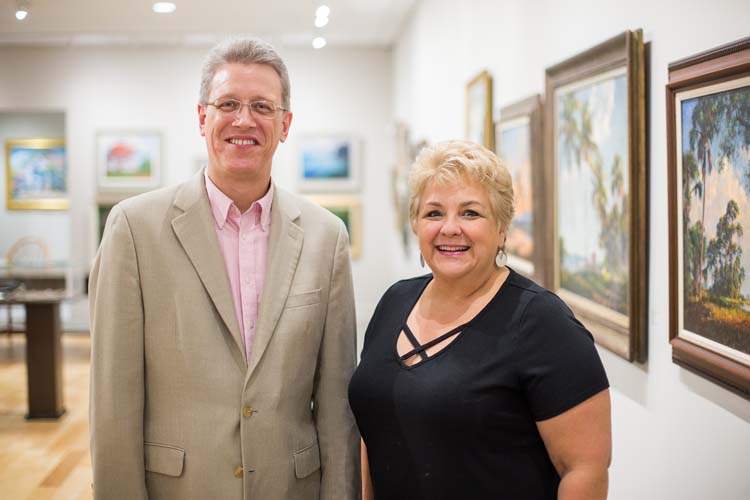
Marshall Adams, education director of the Vero Beach Museum of Art, has left to head Fort Pierce’s A.E. Backus Museum.
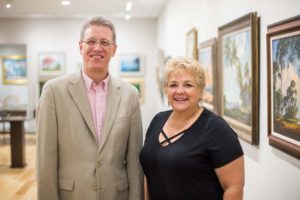
Marshall Adams and Kathleen Frederick
The much smaller and more focused museum in Fort Pierce had been searching nationwide for a new director after the announced retirement of its longtime leader, Kathleen Fredrick, later this month.
For nine years, Adams was a key member of the Vero museum’s management, responsible for public programs including an art school that last year served 2300 students, multiple humanities and art lecture series, and a noted docent program of 36 volunteers.
Trading an 80,000-square-foot museum complex for a virtual one-man operation – himself, in the 8,000 square-foot Backus – Adams comes to Fort Pierce’s art museum at a time of significant growth, charged with implementing plans for expansion of its own education programs.
Fredrick did not look forward to having to initiate a new director in the museum’s profound ties to the community of Fort Pierce. Her own background could hardly be replicated, having grown up as a “Backus brat” hanging around the artist’s home and studio. But it was clear as she and the museum’s board reviewed applicants from around the country for her post, the gallery that on her watch grew into a full-fledged museum should never lose sight of its local roots.
It was a great relief when an application came in from just up the road: Marshall Adams, the highly-regarded and well-loved education director at the Vero Beach Museum of Art.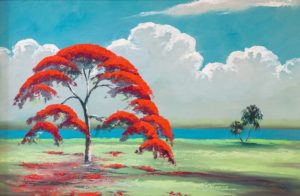
“We were really searching for someone who would mesh well with this community. We didn’t imagine we would find somebody this close to home,” a much-relieved Fredrick. She isn’t the only one relieved. The beloved Backus, which dates to 1960 when it opened as a public gallery, had as its main support a community of artists and art lovers, led by Backus himself.
Trained in summer sessions at Parsons and influenced by the French impressionist, Backus focused his painting on landscapes around Fort Pierce. He lived modestly and generously, sharing tips with African-American painters living nearby (they became known later as the Florida Highwaymen). When Bean Backus died 30 years later, the work of building support for the gallery fell to those who had known and loved him, Fredrick chief among them.
The museum holds many of his works as well as top examples of those artists he mentored. The Backus and Highwaymen paintings, while having gone on to acquire national renown, remain part of the town’s cultural iconography.
That connection is critical to the survival of the museum. “We don’t have a cadre of wealthy donors like some museums,” says Fredrick. “We have always been sustained by the community.”
On Sept. 24, a Sunday, Adams and Fredrick will be hosting an ice cream social to introduce Adams to Backus supporters, while bidding farewell to Fredrick.
“We’re trying to create this smooth transition,” says Adams, who has already begun putting regular hours in at the museum, on the Fort Pierce downtown waterfront.
Adams will be a significant loss to the Vero museum. Over the course of close to a decade there, Adams began or expanded a number of programs. Along with overseeing the education wing where a crowded schedule of classes has nourished tens of thousands of adults and children, Adams selected and trained the museum’s highly regarded docents, what he proudly calls “the front line to visitors.” The docents now number 36. “They were the most professional volunteers that I’ve ever worked with. They were amazing,” Adams says.
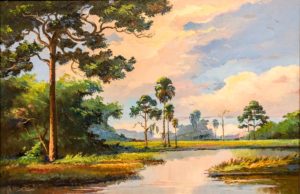 Last week, those docents threw a big party for their departing leader.
Last week, those docents threw a big party for their departing leader.
“He is well-loved,” says Shotsi Lajoie, an artist and mental health counselor who leads a class in art for Alzheimer patients and their caregivers. “He was in charge of a big chunk of the museum’s offerings.”
Having grown up in Jackson, Mississippi, Adams graduated in studio art from Tulane University in New Orleans. His concentration was drawing, opting to earn a B.A. degree rather than a B.F.A. because it allowed more art history classes.
He came to Vero Beach in 2007 from Jacksonville, where for five years he was director of education and exhibitions at the Museum of Contemporary Art. During that time, he earned a master’s degree in museum education leadership from Banks Street College in New York.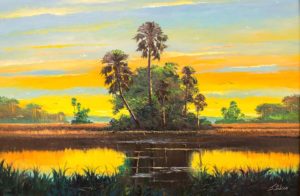
Adams’ departure marks the fourth personnel change in the Vero Beach Museum of Art staff. Executive director Lucinda Gedeon retired last fall; Brady Roberts, former chief curator at the Milwaukee Art Museum, has taken her place. Curator Jay Williams retired at around the same time. His replacement is Dr. Danielle Johnson, a former curatorial assistant at MoMA in New York and a professor of art history at New York University. Joe Ellis has left after 36 years at the museum in public relations and marketing. And the museum’s store lost its longtime manager, Jo Anne Miller.
Asked for comment on Adams’ departure, the Vero museum offered none, other than to say a nationwide search for his replacement was being launched this month.
Adams says he is particularly excited to be involved with a museum dedicated to an artist like Backus, considered a leading American landscape artist. Known for mentoring the African-American ‘outsider’ artists who call themselves the Florida Highwaymen, Backus painted from his home not far from the downtown Fort Pierce gallery he helped found – now the museum of his works, among others. From the 1950s through the mid-1990s, Backus was host to a troupe of visitors – including an adolescent Kathleen Fredrick, among dozens of Fort Pierce teenagers.
At the Backus Museum, one of Adams’ first initiatives will be the creation of an art curriculum for public school students. It will be tied in to academics covered in standardized testing. The curriculum, geared to fourth and fifth graders, will enrich their experience at the museum when they visit on field trips, Fredrick says, meshing, for example, art history with Florida history, says Fredrick.
“Every museum in this country has to reach out to the youth or they will cease to be relevant in very short order,” declares Fredrick.
“This program is consistent with Backus’s own philosophy and practice,” adds Adams. “His doors were always open to kids throughout the community. He wanted to make sure creativity and learning were accessible to everybody.”
Another big change will be the expansion of art classes for “lifelong artists.” For some time, art classes have fallen by the wayside at the Backus as the focus has been on growth and financial support.
And a more adventurous exhibition schedule is expected to take shape. This year, the signature show was Fredrick’s choice: On the Edge of Madness, featuring works by Salvador Dali and other surrealists.
As for the two well-respected juried art shows the museum holds, Adams will assume their staging too. The labor-intensive preparations include physically taking in all submission for both the Best of the Best show and for the photography show, The Eye of the Camera.
Those exhausting efforts are being replaced by a new creative effort by Fredrick in her retirement: She wants to finish a novel. To that end, she heads off at the end of November for a year in Panama, renting a house on a coffee plantation in Boquete. Tentatively titled “Motel Art,” her novel has a good start: she has six chapters written, but the effort was interrupted by the sudden loss of her husband four years ago. “I put it away when he died. I just want to know if I can do it.”
Adams is fervently hoping for a decent cellphone connection, and by Fredrick’s estimation, he’ll need one. “It’s a very multi-faceted job and your almost a staff of one,” she says. “I have a tremendous amount of institutional knowledge that I couldn’t possibly cram into his head at once.”



